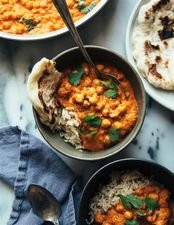This is one of my personal favourites. It’s a healthy and nutritious comfort food made exclusively with ingredients from the pantry and garden. It's easier to put this together in a kitchen but a solar oven and gas mini-stove or small fire off-grid work too.
Ingredients
1/2-2/3 cup dried chickpeas
1 can of tomatoes with juice (can be substituted with tomato paste/powder and water or 3-4 chopped medium sized tomatoes from the garden)
1-2 tbsp ground garam masala
1 tsp coriander seeds
1 tsp ground coriander
1 pinch of ground cardamom
1/2 tsp ground ginger (or 1 tsp of fresh ginger)
1/3ish tsp garlic powder (or 1-2 cloves of garlic) to taste
1ish tsp onion powder (or 1 onion)
1 tsp ground turmeric
1/2 tsp paprika (or 1/2 a capsicum)
1 cup of fresh spinach or chard
2 tbsp neutral coconut oil (for frying)
1/3-1/2 cup of coconut butter (or 1 cup of coconut cream)
1 tsp salt and pepper
1 tbsp lime juice (or fresh lime/lemon wedges)(optional)
1-3 tsp sugar (optional)
up to a cup of other garden veges (optional)
This goes well served with basmati rice and/or with the pita bread recipe from my last post about off-grid hummus. https://peakd.com/food/@freedomnz/off-grid-hummus-and-pita-bread
Soak chickpeas overnight. When ready to cook, move to a pot or solar cooker, cover with plenty of water and cook on medium until soft. This should take approximately about an hour or so, but maybe longer in a solar cooker. After they are cooked, drain and rinse. If you are making breads start this process now too.
Heat 1 tbsp of coconut oil on medium in a pan, add the chickpeas and salt and saute until they are browned and starting to crisp up a bit. Then remove them into a separate bowl.
Add another 1 tbsp of coconut oil to the pan then add the garlic, onion, ginger and coriander seeds and lightly brown, then add the spices and cook for a further minute or so. If using all powders then add all the spices and powders at the same time. Take care not to burn the ingredients at this stage to avoid a bitter flavour in the curry.
(If using additional non-leafy greens from the garden (i.e zucchini, capsicum, potato, broccoli, cauliflower etc) add these in after garlic/onions but before the spices and give some extra time to soften with a light brown. Add more coconut oil to account for extra vegetables as well.)Once the everything starts to become aromatic but not burning, add chickpeas back into the pan and cook for 2-3 minutes, then mix in the tomatoes and simmer on a medium heat for about 10 minutes.
If you have the room and pots available, wilt the leafy greens with a 1/2 cup of water in a pot. Once almost wilted add the coconut butter to the pot and mix. Once the coconut butter dissolves into the water to make a coconut cream/milk add the full contents to the curry. Mix and continue to simmer covered for 15-20 mins. If using more pots is not convenient, just add greens, coconut butter and water to the curry directly and continue to simmer. Add water as needed to maintain moisture in the curry and mix occasionally. Once reduced to a little more watery than preferred for eating, remove from the heat and rest for 5-10 minutes then serve with rice and/or breads.
(Starting the rice and breads 5 mins before curry is taken off is ideal for synchronising the serve times, but if space is limited then doing this while the curry is resting is ok as well.)
I think adding plenty of coriander leaves would be a great garnish so I’m looking forward to my garden producing plenty of those this coming summer. A squeeze of fresh lemon or lime juice makes a good addition if available. Adding sugar does make it more of a comfort food but is not required. It can be dissolved in after the tomatoes are added.
This is a great healthy meal that can be made off-grid using exclusively long shelf-life non-refrigerated 100% vegan ingredients. Adding some cashew butter and/or other nuts further enhance the flavour, texture and amino-acid profile of the dish, but as it stands it’s really good!

